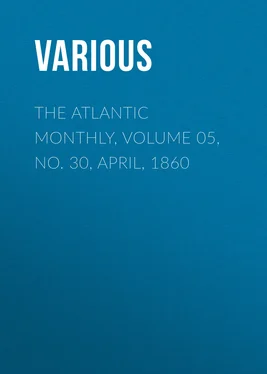Various - The Atlantic Monthly, Volume 05, No. 30, April, 1860
Здесь есть возможность читать онлайн «Various - The Atlantic Monthly, Volume 05, No. 30, April, 1860» — ознакомительный отрывок электронной книги совершенно бесплатно, а после прочтения отрывка купить полную версию. В некоторых случаях можно слушать аудио, скачать через торрент в формате fb2 и присутствует краткое содержание. Жанр: foreign_antique, periodic, foreign_edu, на английском языке. Описание произведения, (предисловие) а так же отзывы посетителей доступны на портале библиотеки ЛибКат.
- Название:The Atlantic Monthly, Volume 05, No. 30, April, 1860
- Автор:
- Жанр:
- Год:неизвестен
- ISBN:нет данных
- Рейтинг книги:5 / 5. Голосов: 1
-
Избранное:Добавить в избранное
- Отзывы:
-
Ваша оценка:
- 100
- 1
- 2
- 3
- 4
- 5
The Atlantic Monthly, Volume 05, No. 30, April, 1860: краткое содержание, описание и аннотация
Предлагаем к чтению аннотацию, описание, краткое содержание или предисловие (зависит от того, что написал сам автор книги «The Atlantic Monthly, Volume 05, No. 30, April, 1860»). Если вы не нашли необходимую информацию о книге — напишите в комментариях, мы постараемся отыскать её.
The Atlantic Monthly, Volume 05, No. 30, April, 1860 — читать онлайн ознакомительный отрывок
Ниже представлен текст книги, разбитый по страницам. Система сохранения места последней прочитанной страницы, позволяет с удобством читать онлайн бесплатно книгу «The Atlantic Monthly, Volume 05, No. 30, April, 1860», без необходимости каждый раз заново искать на чём Вы остановились. Поставьте закладку, и сможете в любой момент перейти на страницу, на которой закончили чтение.
Интервал:
Закладка:
We have said that a curved line is one in which every point is subject to one and the same law of position. Now it may be easily proved, that, in a series of points in a plane, each of which fulfils one and the same condition of position, any three, if taken sufficiently near each other, lie in one straight line. A fourth point near the third lies, then, in a straight line with the second and third,—a fifth with the third and fourth, and so on. The whole series of points must, in short, form a line. But it may also be easily proved that any four of these points, taken sufficiently near each other, lie in the arc of a circle. How strange the paradox to which we are thus led! Every law of a curve, however simple, leads to the same conclusion; a curve must bend at every point, and yet not bend at any point; it must be nowhere a straight line, and yet be a straight line at every part. The blacksmith, passing an iron bar between three rollers to make a tire for a wheel, bends every part of it infinitely little, so that the bending shall not be perceptible at any one spot, and shall yet in the whole length arch the tire to a full circle. It may be that in this paradox lies an additional charm of the curved outline. The eye is pleased to find itself deceived, lured insensibly round into a line running in a different direction from that on which it started.
The simplest law of position for a point would be, either to have it in a given direction from a given point,—a law which would manifestly generate a straight line,—or else to have it at a given distance from the given point, which would generate the surface of a sphere, the outline of which is the circumference of a circle. The straight line fulfils part of the conditions of beauty demanded by the first canon, but not the whole,—it has no variety, and must be combined in order to produce a large effect. The simplest combination of straight lines is in parallels, and this is its usual combination in works of Art. The circle also fulfils but imperfectly the demands of the fundamental canon. It is the simplest of all curves, and the standard or measure of curvature,—vastly more simple in its laws than any rectilineal figure, and therefore more beautiful than any simple figure of that kind. There is, however, a sort of monotony in its beauty,—it has no variety of parts.
The outline of a sphere, projected by the beholder against any plane surface behind it, is a circle only when a perpendicular, let fall on the plane from the eye, passes through the centre of the sphere. In other positions the projection of the sphere becomes an ellipse, or one of its varieties, the parabola and hyperbola. The parabola is the boundary of the projection of a sphere upon a plane, when the eye is just as far from the plane as the outer edge of the sphere is, and the hyperbola is a similar curve formed by bringing the eye still nearer to the plane.
By these metamorphoses the circle loses much of its monotony, without losing much of its simplicity. The law of the projection of a sphere upon a plane is simple, in whatever position the plane may be. And if we seek a law for the ellipse, or either of the conic sections, which shall confine our attention to the plane, the laws remain simple. There are for these curves two centres, which come together for the circle, and recede to an infinite distance for the parabola; and the simple law of their formation is, that the curve everywhere makes equal angles with the lines drawn to these two centres. According to the fundamental canon, a conic section should be a beautiful curve; and the proof that it is so is to be found in the attention which these curves have always drawn upon themselves from artists and from mathematicians. Plato, equally great in mathematics and in metaphysics, is said to have been the first to investigate the properties of the ellipse. For about a century and a half, to the time of Apollonius, the beauty of this curve, and of its variations, the parabola and hyperbola, so fascinated the minds of Plato's followers, that Apollonius found theorems and problems relating to these figures sufficient to fill eight books with condensed truths concerning them. The study of the conic sections has been a part of polite learning from his day downward. All men confess their beauty, which so entrances those of mathematical genius as entirely to absorb them. For eighteen centuries the finest spirits of our race drew some of their best means of intellectual discipline from the study of the ellipse. Then came a new era in the history of this curve. Hitherto it had been an abstract form, a geometrical speculation. But Kepler, by some fortunate guess, was led to examine whether the orbits of the planets might not be elliptical, and, lo! it was found that this curve, whose beauty had so fascinated so many men for so many ages, had been deemed by the great Architect of the Heavens beautiful enough to introduce into Nature on the grandest scale; the morning stars had been for countless ages tracing diagrams beforehand in illustration of Apollonius's conic sections. It seemed that this must have been the design of Providence in leading Plato and his followers to investigate the ellipse, that Kepler might be prepared to guide men to a knowledge of the movements of the heavenly bodies. "And," said Kepler, "if the Creator has waited so many years for an observer, I may wait a century for a reader." But in less than a century a reader arose in the person of the English Newton. The ellipse again appeared in human history, playing a no less important part than before. For, as it was only by a profound knowledge of ellipses that Kepler could establish his three beautiful facts with regard to the motions of the planets, so also was it only through a still more perfect and intimate acquaintance with the minute peculiarities of that curve that Sir Isaac Newton could demonstrate that these three facts were perfectly accounted for only by his theory of universal gravitation,—the most beautiful theory ever devised, and the most firmly established of all scientific hypotheses. If the ellipse, as a simply geometrical speculation, has had so much power in the education of the race, what are the intellectual relations of its beauty through its connection with astronomy? Who can estimate the influence which this oldest of physical sciences has had upon human destiny? Who can tell how much intellectual life and self-reliance, how much also of humility and reverential awe, how much adoration of Divine Wisdom, have been gained by man through his study of these heavenly diagrams, marked out by the sun and the moon, by the planets and the comets, upon the tablets of the sky? Yet, without the ellipse, without the conic sections of Plato and Apollonius, astronomy would have been to this day a sealed science, and the labors of Hipparchus, Ptolemy, Tycho, and Copernicus would have waited in vain for the genius of Kepler and of Newton to educe divine order from the seeming chaos of motions.
But the obligations of man to the ellipse do not end here. The eighteenth and nineteenth centuries also owe it a debt of gratitude. Even where the knowledge of conic sections does not enter as a direct component of that analytical power which was the glory of a Lagrange, a Laplace, and a Gauss, and which is the glory of a Leverrier, a Peirce, and their companions in science, it serves as a part of the necessary scaffolding by which that skill is attained,—of the necessary discipline by which their power was exercised and made available for the solution of the great problems of astronomy, optics, and thermotics, which have been solved in our century.
There is another curve, generated by a simple law from a circle, which has played an important part at various epochs in the intellectual history of our race. A spot on the tire of a wheel running on a straight, level road, will describe in the air a series of peculiar arches, called the cycloid. The law of its formation is simple; the law of its curvature is also simple. The path in which the spot moves curves exactly in proportion to its nearness to the lowest point of the wheel. By the simplicity of its law, it ought, according to the canon, to be a beautiful curve. Now, although artists have not shown any admiration for the cycloid, as they have for the ellipse, yet the mathematicians have gazed upon it with great eagerness, and found it rich in intellectual treasures. Chasles, in his History, says that the cycloid interweaves itself with all the great discoveries of the seventeenth century.
Читать дальшеИнтервал:
Закладка:
Похожие книги на «The Atlantic Monthly, Volume 05, No. 30, April, 1860»
Представляем Вашему вниманию похожие книги на «The Atlantic Monthly, Volume 05, No. 30, April, 1860» списком для выбора. Мы отобрали схожую по названию и смыслу литературу в надежде предоставить читателям больше вариантов отыскать новые, интересные, ещё непрочитанные произведения.
Обсуждение, отзывы о книге «The Atlantic Monthly, Volume 05, No. 30, April, 1860» и просто собственные мнения читателей. Оставьте ваши комментарии, напишите, что Вы думаете о произведении, его смысле или главных героях. Укажите что конкретно понравилось, а что нет, и почему Вы так считаете.












